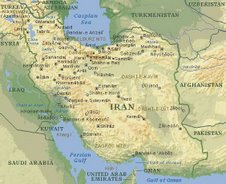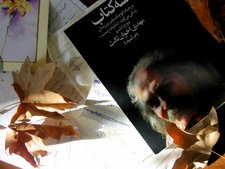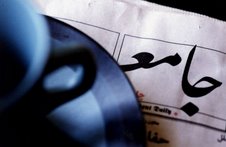
by Muriel Mirak-Weissbach
August 31, 2007
President Bush's most recent ranting, in which he accused Iran of threatening to unleash a "nuclear holocaust," must be seen, for sure, in the context of the drumbeat for military aggression against the Islamic Republic.
Within the space of a few days, several articles appeared in the mainstream press, indicating that the Cheney project for launching a new war is on the front burner. Most explicit was the report of two British think tankers, Daniel Pletsch and Martin Butcher, issued on August 27 and leaked by Raw Story the following day. Their study, entitled, "Considering a war with Iran: A discussion paper on WMD in the Middle East," claimed that the US could destroy Iran's nuclear program, industrial base and government infrastructure within days.
But Bush's specific reference to Iran's alleged ambitions to develop a nuclear bomb, should be placed in the category of one who "doth protest too much." What Bush did NOT mention is a development of major significance, which may well have been the trigger for his wild assertions. This was the agreement reached by the International Atomic Energy Agency and Iran, which proved that the persistent, rigorous approach pursued by the IAEA, to solve the conflict over Iran's nuclear energy program through diplomatic means, has yielded results which the Agency itself has dubbed a breakthrough. The contention of the Bush-Cheney administration, which is bent on war at all costs, has been that the efforts of the European Union group of three (Great Britain, Germany and France) as well as those of the IAEA, have been destined to failure, since Tehran was only interested in gaining time to build its bomb.
Iranian President Mahmoud Ahmadinejad, speaking to journalists in Tehran on August 28, announced unequivocably that he believed, on the basis of the agreement with the IAEA, that the entire matter should be considered "closed." This was not empty rhetoric of the sort often attributed to Ahmadinejad, but a statement of fact, as documented in the "Understandings of the Islamic Republic of Iran and the IAEA on the modalities of resolution of the outstanding issues," published on August 29, by the new Iranian all news station News TV, among others. The text makes clear that the discussion process involving Iranian chief negotiator Ali Larijani and his IAEA interlocutors, including Director General Mohammad ElBaradei, has borne its desired fruits: to wit, that through the question-and-answer process, whereby the IAEA has raised its queries regarding specific aspects of Iran's program and Iran has given its clarifications, has satisfied the agency's demands. In sum, the document states that certain specific issues have been fully resolved, and that those yet to be resolved, will be dealt with in the same manner, such that specific timeframes can be defined for "closing the dossier," as Ahmadinejad put it.

The text of the agreement was published on request of Iran, "as an INFCIRC document and to be made available to the public through the IAEA website." It states: "Pursuant to the negotiations between H.E. Dr. Larijani, I. R. of Iran's Secretary of Supreme National Security Council and H.E. Dr. ElBaradei, Director General of the IAEA, in Vienna; following the initiative and good will of the Islamic Republic of Iran and the agreement made, a high ranking delegation consisting of the directors of technical, legal and political departments of the IAEA, paid a visit to Tehran from 11 to 12 July 2007 during which 'Understandings of The Islamic Republic of Iran and the IAEA on the Modalities of Resolution of the Outstanding Issues, Tehran 12 July 2007' were prepared."
The text reports on the following meetings that took place in Vienna and Tehran on July 24, and August 20-21, following which "both Parties reached the following understandings...." First, regarding the enirchment program, which has been targetted by the Bush-Cheney cabal as "proof" that Tehran wants the bomb. "The Agency and Iran agreed to cooperate in preparing the safeguards approach for the Natanz Fuel Enrichment Plant in accordance with Iran's Comprehensive Safeguards Agreement. The draft text of the safeguards approach paper, and the facility attachment of IRN- were provided to Iran on 23 July 2007. The safeguards approach and the facility attachment were discussed during technical meetings in Iran between the Agency and the AEOI from 6 to 8 August 2007. Further discussions will be held with the aim of finalizing the facility attachment by the end of September 2007."
As for the heavy water reactor in Arak, "Iran agreed with the Agency's request to visit the heavy water research reactor (IR40) site in Arak. A successful visit took place on 30 July 2007." Furthermore, it is reported that "On 12 July 2007, Iran accepted the designation of five additional inspectors" and "On 12 July 2007, Iran agreed to issue one year multiple entry visas for 14 inspectors and staff of the Agency."
Under the rubric of "Past Outstanding Issues," the question of plutonium experiments was dealt with. Here, the joint text reports that in the course of July and August, the IAEA presented questions, and Iran, answers, to various issues. Then, in a sentence which might have caused heart tremors for Dick Cheney, the text states: "On 20 August 2007 the Agency stated that earlier statements made by Iran
Regarding other vital issues, a clear timeline is set for the question-and-answer process to yield its results. regarding the issue of P1-P2, the IAEA says the Pu experiments should close by August 31, and that it will therefore provide all its remaining questions to Iran by that date. Discussions are scheduled then for September 24-25 in Tehran, followed by a mid-October meeting, both to clarify the questions. "The Agency's target date for the closure of this issue is November 2007," says the text.
And, for remaining issues, the same sensible approach is adopted: "once all the above mentioned issues are concluded and their files are closed," further questions can be submitted by the IAEA, again with specific dates, and Iran will respond, within deadlines.
In a final paragraph entitled "General Understandings," the document asserts five points which must have sent Bush ballistic. Since it is absurd to imagine that the establishment press will give the public any insight into what is going on here between the IAEA and Iran, it is worth quoting the points in full:
"1. These modalities cover all remaining issues and the Agency confirmed that there are no other remaining issues and ambiguities regarding Iran's past nuclear program and activities.
2. The Agency agreed to provide Iran with all remaining questions according to the above work plan. This means that after receiving the questions, no other questions are left. Iran will provide the Agency with the required clarifications and information.
3. The Agency's delegation is of the view that the agreement on the above issues shall further promote the efficiency of the implementation of safeguards in Iran and its ability to conclude the exclusive peaceful nature of the Iran's nuclear activities.
4. The Agency has been able to verify the non-diversion of the declared nuclear materials at the enrichment facilities in Iran and has therefore concluded that it remains in peaceful use.
5. The Agency and Iran agreed that after the implementation of the above work plan and the agreed modalities for resolving the outstanding issues, the implementation of safeguards in Iran will be conducted in a routine manner."
The gist of this document is that, contrary to the hysterical ravings from the White House, diplomacy does work, and that if Iran were treated as a normal country, with due respect, as Tehran has always insisted, then progress could be made on any front. The implications of the IAEA-Iran "understandings" are profound: we are not dealing here with a "rogue state" or a member of the "axis of evil," but with a sovereign nation which correctly asserts its right to nuclear energy technology, in the framework of the IAEA and NPT.
The fact that the IAEA reached this groundbreaking agreement has thrown a major monkey-wrench into the Bush-Cheney cabal's plans for war, based on their claims that Iran is building the bomb. But then, Washington will quickly retort, aren't the Iranian Revolutionary Guards killing our troops in Iraq?









